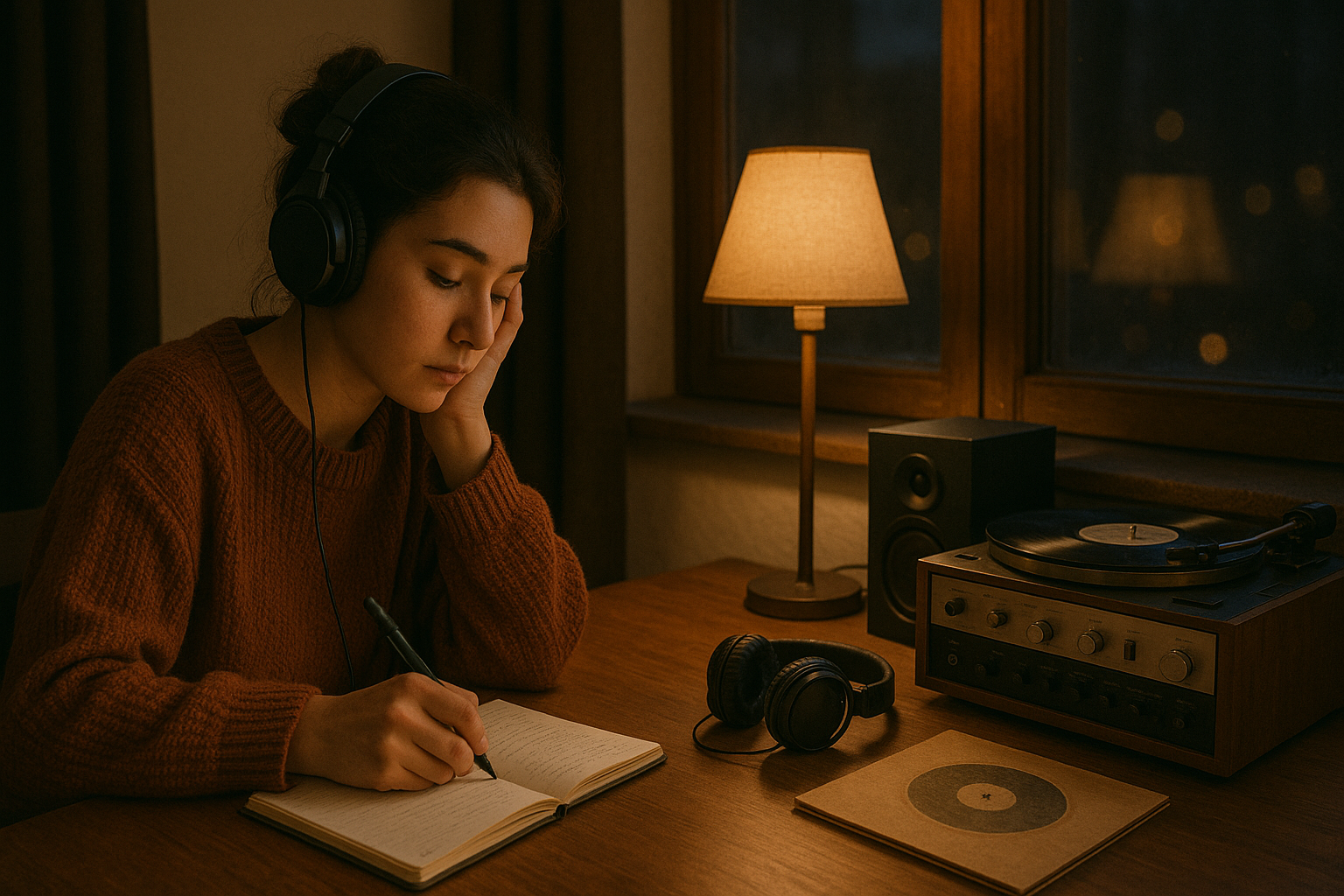May 7, 2025
Generate Lo-Fi Music with Neume.io

Anisha Karki

Contents
- What is Lo-Fi Music?
- Elements of Lo-Fi Music
- The Rise of Lo-Fi Music
- Key artists and albums
- Step-by-Step Guide to Generate Lo-Fi Music with Neume.io.
- Exploring Neume.io's Lo-Fi Capabilities
- The Benefits of Using AI for Lo-Fi Creation
- Limitations of Using AI for Lo-Fi Creation
- Ethical Considerations and the Future of AI Music
The world of music is constantly evolving, and in recent years, a genre characterized by its laid-back vibes, comforting imperfections, and nostalgic charm has captured the hearts of millions: Lo-Fi music. Often described as the sonic equivalent of a warm embrace or a rainy afternoon, Lo-Fi has transcended its underground origins to become a significant cultural phenomenon. This guide will delve into the essence of Lo-Fi music and explore how Neume.io, a powerful and accessible platform, can be your gateway to creating your very own captivating Lo-Fi beats.
What is Lo-Fi Music?
Lo-Fi, short for "low fidelity," is a genre of music characterized by intentional imperfections in its recording and production quality. Unlike the polished and pristine sound often associated with mainstream music.
Elements of Lo-Fi Music
- Subtle Imperfections: Hiss, crackle, tape warble, and minor recording errors are not seen as flaws but rather as integral parts of the genre's aesthetic.
- Relaxed Tempo and Groove: Lo-Fi tracks typically feature slow to moderate tempos and a relaxed, often slightly swung or "off-kilter" groove.
- Repetitive and Hypnotic Elements: Loops, simple chord progressions, and recurring melodic fragments contribute to the genre's meditative and calming qualities.
- Warm and Mellow Tones: Analog-inspired sounds, mellow synthesizers, warm basslines, and dusty drum samples are common sonic ingredients.
- Nostalgic and Evocative Atmosphere: Lo-Fi often evokes feelings of nostalgia, comfort, introspection, and a sense of peaceful solitude.
Beyond its sonic characteristics, Lo-Fi music holds significant cultural significance. It has become the soundtrack for studying, relaxing, working, and unwinding for a vast online community. The genre's accessibility and the ease with which it can be created have fostered a thriving ecosystem of independent artists sharing their creations on platforms like YouTube, SoundCloud, and Spotify. The iconic "Lo-Fi hip hop radio - beats to relax/study to" streams have become cultural touchstones, embodying a sense of online community and shared experience.
The emotional impact of Lo-Fi music on listeners is profound. Its calming and unobtrusive nature can enhance focus and concentration. The nostalgic elements can evoke pleasant memories and a sense of comfort. The overall atmosphere often promotes relaxation, reduces stress, and provides a sonic sanctuary in a fast-paced world.
The Rise of Lo-Fi Music
The historical development of Lo-Fi music can be traced back to various influences:
- DIY Ethos: The punk and indie rock movements of the late 20th century championed a do-it-yourself approach to music creation, often embracing raw and unpolished sounds out of necessity or artistic choice.
- Cassette Culture: The accessibility of cassette tapes and four-track recorders in the 80s and 90s allowed artists to experiment and create music outside of professional studios, leading to a proliferation of home-recorded and lo-fi sounds.
- Experimental and Ambient Music: Artists exploring unconventional sounds and textures laid the groundwork for appreciating sonic imperfections and atmospheric soundscapes.
- Chillwave and Vaporwave: These internet-born subgenres of the early 2010s embraced nostalgic aesthetics and hazy, lo-fi production techniques, paving the way for the mainstream acceptance of Lo-Fi hip hop.
Key artists and albums
Several key artists and albums shaped the genre. While the definition of "Lo-Fi" is broad, influential figures include:
- J Dilla: His "slum village" era and later instrumental hip-hop work often featured a raw, soulful, and slightly off-kilter production style that is a clear precursor to modern Lo-Fi hip hop.
- Nujabes: The Japanese producer's smooth jazz-infused hip-hop instrumentals with their warm samples and gentle rhythms are considered foundational to the genre.
- Boards of Canada: Their atmospheric electronic music with its vintage synth sounds, tape hiss, and melancholic melodies embodies a different, more electronic-leaning side of Lo-Fi.
- Early Chillwave artists: Acts like Washed Out and Toro y Moi embraced hazy, reverb-drenched sounds and lo-fi aesthetics in their early work.
The influence of technology on the growth of Lo-Fi music is undeniable. The rise of affordable digital audio workstations (DAWs), readily available samples and loops, and the internet as a distribution platform democratized music creation. Platforms like SoundCloud allow independent artists to share their lo-fi creations with a global audience, fostering communities and driving the genre's popularity. Today, user-friendly online tools like Neume.io further lower the barrier to entry, making music creation accessible to anyone with a creative spark.
Step-by-Step Guide to Generate Lo-Fi Music with Neume.io.
There are simple steps to follow for creating Lo-Fi music with Neume.io:
- Sign Up/Create an Account: Head over to the Neume.io website and follow the prompts to create your account. This usually involves providing an email address and setting a password.
- Navigate the Platform: Once logged in, familiarize yourself with the Neume.io interface. It's rather straight forward - all you need to do is enter your style and lyrics.
- Describe your song idea: On Style write about your song idea or explore moods like "chill", "relaxing", "ambient" or "dreamy", which often produce sounds in the Lo-Fi vein.
- Generate the Track: Once you've described your song click the "Generate" button.
- Preview and Listen: Neume.io will then generate a piece of music based on your input. Take the time to listen to the generated track. Pay attention to the beat, melody, and overall vibe
- (Optional) Download: If you like what you hear, you can click the three dots next to your song to reveal an option to download the file.
Exploring Neume.io's Lo-Fi Capabilities
Neume.io's AI algorithms are designed to understand the nuances of different musical genres, and for Lo-Fi, this translates into the generation of specific sonic elements that define the style:
- Beats: Expect to hear the characteristic laid-back drum patterns. These are often simple, repetitive, and might have a slightly "off-grid" or swung feel, contributing to the relaxed atmosphere. The drum sounds themselves often lean towards classic drum machines or sampled, slightly dusty sounds.
- Melodies: Lo-Fi melodies are typically simple, memorable, and often carry a sense of calmness or even melancholy. Neume.io can generate these kinds of understated melodic lines, often played on mellow instruments like pianos, synthesizers, or guitars.
- Chords: The harmonic foundation of Lo-Fi often involves relaxed and slightly jazzy chord progressions. You might hear seventh chords or other extended harmonies that create a smooth and mellow feel. Neume.io is likely trained to generate these types of chord sequences.
- Instrumentation: The instruments typically found in Lo-Fi – such as electric pianos with a warm tone, soft analog-style synthesizers, clean or slightly chorus-y electric guitars, and understated basslines – are likely to be the sonic palette that Neume.io draws upon when generating Lo-Fi tracks.
The Benefits of Using AI for Lo-Fi Creation
Utilizing AI tools like Neume.io for generating Lo-Fi music offers several compelling advantages:
- Accessibility for All: You don't need to be a seasoned musician with years of practice to create your own Lo-Fi tracks. AI lowers the barrier to entry, allowing anyone with an interest to explore music creation.
- Speed and Efficiency: AI can generate musical ideas and even complete tracks in a fraction of the time it would take a human composer. This allows for rapid prototyping and the creation of a large volume of music quickly.
- Overcoming Creative Blocks: If you're a musician facing a creative rut, AI can be a valuable source of inspiration, generating unexpected melodies and chord progressions that can spark new ideas.
- Generating Background Music: Whether you're a content creator needing royalty-free background music for your videos or simply want personalized Lo-Fi for your own enjoyment, AI offers a convenient solution.
Limitations of Using AI for Lo-Fi Creation
While AI-powered music creation tools like Neume.io offer exciting possibilities for generating Lo-Fi beats, it's crucial to acknowledge their inherent limitations, especially when aiming for the nuanced and emotionally resonant qualities that define the genre. Here are some key limitations:
- Lack of Authentic "Human Feel" and Imperfection: Lo-Fi music inherently embraces imperfections – the subtle hiss of tape, the slight drag in rhythm, the warm distortion of analog gear. These aren't mistakes; they contribute significantly to the genre's charm and nostalgic atmosphere. AI, by its nature, tends towards precision and can struggle to authentically replicate these organic flaws. The "feel" of a human-played instrument or a carefully manipulated analog recording is often lost in purely AI-generated output.
- Difficulty in Emulating Subjectivity and Emotional Depth: Lo-Fi music often carries a personal touch, reflecting the creator's mood, experiences, and unique perspective. It can evoke feelings of nostalgia, introspection, or peaceful solitude. AI, lacking personal history and emotions, generates music based on patterns and data it has learned. While it can create music that sounds melancholic or relaxing, it may lack the genuine emotional depth and subjective nuances that a human artist imbues into their work. The subtle emotional cues and the story behind a piece of Lo-Fi often stem from human experience, something AI cannot truly replicate.
- Potential for Derivative Output and Limited Innovation: AI models learn from vast datasets of existing music. This means that the Lo-Fi it generates is often based on patterns and sounds already present in its training data. While this can lead to competent and even pleasant-sounding tracks, it can also result in derivative music that lacks true originality. AI may struggle to break free from established Lo-Fi tropes and create truly innovative or unexpected sonic landscapes. The experimental detours and "happy accidents" that often lead to unique artistic breakthroughs in human music creation are less likely to occur with purely algorithmic generation.
Ethical Considerations and the Future of AI Music
As AI continues to play a larger role in music creation, it's important to consider the ethical implications. Questions surrounding copyright ownership of AI-generated music and the potential impact on human artists are ongoing discussions within the music industry. However, many view AI not as a replacement for human creativity but as a powerful tool that can augment and democratize music creation. The future of Lo-Fi music may well involve a collaborative landscape where human artists and AI tools like Neume.io work together to push the boundaries of the genre and create new and exciting sonic experiences.
Ready to Create Your First Lo-Fi Track?
Dive into the world of chill beats and nostalgic sounds. Neume.io makes it easy to start generating your own Lo-Fi music today.